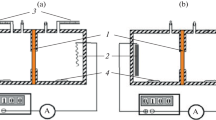Summary
The steady state passive efflux of salt from human red blood cells was measured in various low ionic strength media in which the osmotic pressure ranged from 200 to 600 milliosmolar. Sucrose was used as the nonpenetrating nonelectrolyte. If the flux is plotted against the log of the salt concentration, the data for each tonicity can be fitted by three straight-line segments separated by two sharp inflections, one at low external salt concentrations (0.1 to 0.3mM), confirming observations of LaCelle and Rothstein, and a second at higher salt concentrations (20 to 50 mM). As the osmolarity of the medium is increased, the inflection in every case seems to be uniquely determined by the membrane potential calculated from the Nernst equation with use of the chloride ratio. One inflection occurs at about 45 mV and the second at 170 mV in experiments at five different tonicities. Calculations from the Goldman equation suggest that the inflections represent potential-dependent changes to new permeability states. The osmotic pressure of the medium also influences the permeability. The coefficient is systematically reduced as the osmotic pressure is increased.
Similar content being viewed by others
References
Agin, D. 1967. Electroneutrality and electrodiffusion in the squid axon.Proc. Nat. Acad. Sci. Wash. 57:1232.
Bang, J. 1909. Physiko-chemische Verhältnisse der Blutkörperchen.Biochem. Z. 16:255.
Barr, L. 1965. Membrane potential profiles and the Goldman equation.J. Theoret. Biol. 9:351.
Bass, L., and W. J. Moore. 1967. Electric fields in perfused nerves.Nature 214:393.
Bromberg, P. A., J. Theodore, E. Robin, and W. Jensen. 1965. Anion and hydrogen ion distribution in human blood.J. Lab. Clin. Med. 66:464.
Cook, J. S. 1967. Nonsolvent water in human erythrocytes.J. Gen. Physiol. 50:1311.
Davson, H. 1939. Studies on the permeability of erythrocytes. VI. The effect of reducing the salt content of the medium surrounding the cell.Biochem. J. 33:389.
Drabkin, D. L. 1945. Hemoglobin, glucose oxygen and water in the erythrocyte.Science 101:445.
Funder, J., and J. O. Wieth. 1966. Chloride and hydrogen ion distribution between human red cells and plasma.Acta Physiol. Scand. 68:234.
Gary-Bobo, C. M. 1967. Nonsolvent water in human erythrocytes and hemoglobin solutions.J. Gen. Physiol. 50:2547.
German, B., and J. Wyman. 1937. Titration curves of hemoglobin.J. Biol. Chem. 117:534.
Goldman, D. E. 1943. Potential, impedance, and rectification in membranes.J. Gen. Physiol. 27:37.
— 1964. A molecular structural basis for the excitation properties of axons.Biophys. J. 4:167.
Harris, E. J., and M. Maizels. 1952. Distribution of ions in suspensions of human erythrocytes.J. Physiol. 118:40.
Hill, T. L. 1967. Electric fields and the cooperativity of biological membranes.Proc. Nat. Acad. Sci., Wash. 58:111.
Jacobs, M., and A. K. Parpart. 1932. Osmotic properties of the erythrocyte. V. The rate of hemolysis in hypotonic solutions of electrolytes.Biol. Bull. 63:224.
LaCelle, P., and A. Rothstein. 1966. The passive permeability of the red blood cell to cations.J. Gen. Physiol. 50:171.
Lettvin, J. V., W. F. Packard, W. S. McCulloch, and W. Pitts. 1964. A theory of passive ion flux through axon membrane.Nature 202:1338.
Mueller, P., and D. O. Rudin. 1963. Induced excitability in reconstituted cell membrane structures.J. Theoret. Biol. 4:268.
——. 1967. Action potential phenomena in experimental bimolecular lipid membranes.Nature 213:603.
Nakao, M., T. Nakao, S. Yamazoe, and H. Yoshikawa. 1961. Adenosine triphosphate and shape of erythrocytes.J. Biochem. 49:487.
Ponder, E. 1943. The osmotic behavior of crenated red cells.J. Gen. Physiol. 27:273.
Rich, G.T., R. I. Sha'afi, A. Romualdez, and A. K. Solomon. 1968. Effects of osmolality on the hydraulic permeability coefficient of red cells.J. Gen. Physiol. 52:941.
Robinson, R. A., and R. H. Stokes. 1959. Electrolyte Solutions. 2nd rev. edition. 492. London: Butterworth and Co.
Savitz, D., V. W. Sidel, and A. K. Solomon. 1964. Osmotic properties of human red cells.J. Gen. Physiol. 48:79.
Stein, W. D. 1967. The Movement of Molecules Across Cell Membrane. p. 225. Academic Press Inc., New York.
Tasaki, I., and I. Singer. 1966. Membrane macromolecules and nerve excitability: A physico-chemical interpretation of excitation in squid giant axons.Ann. N. Y. Acad. Sci. 137:792.
Tobias, J. M. 1964. A chemically specified molecular mechanism underlying excitation in nerve: A hypothesis.Nature 203:13.
Vodrážka, Z., and J. Čejka. 1961. Interaction of human hemoglobin with hydrogen ion.Biochim. Biophys. Acta 49:502.
Wei, L. Y. 1969. Role of surface dipoles on axon membrane.Science 163:280.
Whittam, R. 1964. Transport and Diffusion in Red Blood Cells. p. 76. Williams and Wilkins Co., Baltimore.
Wilbrandt, W. 1940. Die Ionpermeabilität der Erythrocyten in Nichtleiterlösungen.Arch. ges. Physiol. 243:537.
Wilbrandt, W., and H. J. Schatzmann. 1960. Changes in the passive cation permeability of erythrocytes in low electrolyte media, p. 340.In Ciba Foundation Study Group Symposium No. 5. Regulation of the Inorganic Ion Content of Cells. Churchill, London.
Author information
Authors and Affiliations
Additional information
Parts of this paper are included in “Passive Cation Efflux from Human Erythrocytes Suspended in Low Ionic Strength Media”, Ph. D. thesis by Jerome A. Donlon, The University of Rochester, 1968.
Rights and permissions
About this article
Cite this article
Donlon, J.A., Rothstein, A. The cation permeability of erythrocytes in low ionic strength media of various tonicities. J. Membrain Biol. 1, 37–52 (1969). https://doi.org/10.1007/BF01869773
Received:
Issue Date:
DOI: https://doi.org/10.1007/BF01869773




